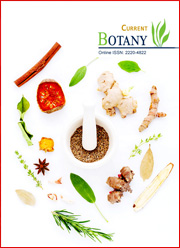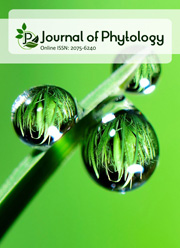In-vitro antioxidant and cytotoxic activities of ethyl acetate extract of Holigarna ferruginea
DOI:
https://doi.org/10.25081/cb.2023.v14.8058Keywords:
Holigarna ferruginea, GC-MS analysis, Antioxidant, Cytotoxic activityAbstract
Higher plants have long been used as traditional medicines to treat human ailments. Approximately 80% of people worldwide utilize plants as safe sources of medicines to heal human diseases via a totally new medicinal system. Holigarna ferruginea is an indigenous medicinal tree plant in the Anacardiaceae family. The plant has a wide range of physiologically active chemicals. GC-MS was used to screen phytochemical substances, while FTIR was used to identify functional groups. GC-MS study revealed 10 major bioactive phytochemical substances that belong to functional groups such as secondary amines, alcohols, ethers, esters, carboxylic acids, and anhydrides. These diverse active phytochemicals have been discovered to have a wide range of actions that may aid in the prevention of illnesses. Higher quantities of phytochemical substances were found in ethyl acetate extracts of leaves. As a result, the extract possesses anticancer and antioxidant activities against Humans Breast cell lines (MCF-7). The viability was reduced when the concentrations of the ethyl acetate extract of H. ferruginea leaves were increased and it may help in the discovery of an ideal therapeutic agent in novel drugs as well as nutritional supplements.
Downloads
References
Adnan, M., Chy, M. N. U., Kamal, A. T. M. M., Chowdhury, K. A. A., Rahman, M. A., Reza, A. S. M. A., Moniruzzaman, M., Rony, S. R., Nasrin, M. S., Azad, M. O. K., Park, C. H., Lim, Y. S., & Cho, D. H. (2020). Intervention in neuropsychiatric disorders by suppressing inflammatory and oxidative stress signal and exploration of in silico studies for potential lead compounds from Holigarna caustica (Dennst.) Oken leaves. Biomolecules, 10(4), 561. https://doi.org/10.3390/biom10040561
Al-Oqail, M. M., Al-Sheddi, E. S., Farshori, N. N., Al-Massarani, S. M., Al-Turki, E. A., Ahmad, J., Al-Khedhairy, A. A., & Siddiqui, M. A. (2019). Corn silk (Zea mays L.) induced apoptosis in human breast cancer (MCF-7) cells via the ROS-mediated mitochondrial pathway. Oxidative Medicine and Cellular Longevity, 2019, 9789241. https://doi.org/10.1155/2019/9789241
Bacanlı, M., Başaran, A. A., & Başaran, N. (2017). The antioxidant, cytotoxic, and antigenotoxic effects of galangin, puerarin, and ursolic acid in mammalian cells. Drug and Chemical Toxicology, 40(3), 256-262. https://doi.org/10.1080/01480545.2016.1209680
Bray, F., Ferlay, J., Soerjomataram, I., Siegel, R. L., Torre, L. A., & Jemal, A. (2018). Global cancer statistics 2018: GLOBOCAN estimates of incidence and mortality worldwide for 36 cancers in 185 countries. CA: A Cancer Journal for Clinicians, 68(6), 394-424. https://doi.org/10.3322/caac.21492
Chao, P.-Y., Lin, S.-Y., Lin, K.-H., Liu, Y.-F., Hsu, J.-I., Yang, C.-M., & Lai, J.-Y. (2014). Antioxidant activity in extracts of 27 indigenous Taiwanese vegetables. Nutrients, 6(5), 2115-2130. https://doi.org/10.3390/nu6052115
Jadhav, V., Kalase, V., & Patil, P. (2014). GC-MS analysis of bioactive compounds in methanolic extract of Holigarna grahamii (wight) Kurz. International Journal of Herbal Medicine, 2(4), 35-39.
Kalaivani, T., & Mathew, L. (2010). Free radical scavenging activity from leaves of Acacia nilotica (L.) Wild. ex Delile, an Indian medicinal tree. Food and Chemical Toxicology, 48(1), 298-305. https://doi.org/10.1016/j.fct.2009.10.013
Karpuz, M., Silindir-Gunay, M., & Ozer, A. Y. (2018). Current and future approaches for effective cancer imaging and treatment. Cancer Biotherapy & Radiopharmaceuticals, 33(2), 39-51. https://doi.org/10.1089/cbr.2017.2378
Kelloff, G. J. (1999). Perspectives on cancer chemoprevention research and drug development. Advances in Cancer Research, 78, 199-334. https://doi.org/10.1016/S0065-230X(08)61026-X
Khan, T., Ali, M., Khan, A., Nisar, P., Jan, S. A., Afridi, S., & Shinwari, Z. K. (2019). Anticancer plants: A review of the active phytochemicals, applications in animal models, and regulatory aspects. Biomolecules, 10(1), 47. https://doi.org/10.3390/biom10010047
Marvibaigi, M., Amini, N., Supriyanto, E., Majid, F. A. A., Jaganathan, S. K., Jamil, S., Almaki, J. H., & Nasiri, R. (2016). Antioxidant activity and ROS-dependent apoptotic effect of Scurrula ferruginea (Jack) danser methanol extract in human breast cancer cell MDA-MB-231. PLoS One, 11(7), e0158942. https://doi.org/10.1371/journal.pone.0158942
Mosmann, T. (1983). Rapid colorimetric assay for cellular growth and survival: application to proliferation and cytotoxicity assays. Journal of Immunological Methods, 65(1-2), 55-63. https://doi.org/10.1016/0022-1759(83)90303-4
Nobili, S., Lippi, D., Witort, E., Donnini, M., Bausi, L., Mini, E., & Capaccioli, S. (2009). Natural compounds for cancer treatment and prevention. Pharmacological Research, 59(6), 365-378. https://doi.org/10.1016/j.phrs.2009.01.017
Palithya, S., Gaddam, S. A., Kotakadi, V. S., Penchalaneni, J., Golla, N., Krishna, S. B. N., & Naidu, C. V. (2022). Green synthesis of silver nanoparticles using flower extracts of Aerva lanata and their biomedical applications. Particulate Science and Technology, 40(1), 84-96. https://doi.org/10.1080/02726351.2021.1919259
Panda, S. K., Das, R., Mai, A. H., De Borggraeve, W. M., & Luyten, W. (2020). Nematicidal activity of Holigarna caustica (Dennst.) oken fruit is due to linoleic acid. Biomolecules, 10(7), 1043. https://doi.org/10.3390/biom10071043
Pehlivan, F. E. (2017). Vitamin C: An antioxidant agent. In A. H. Hamza (Eds.), Vitamin C (pp. 23-35) London, UK: IntechOpen Limited. https://doi.org/10.5772/intechopen.69660
Quispe-Candori, S., Foglio, M. A., Rosa, P. T. V., & Meireles, M. A. A. (2008). Obtaining β-caryophyllene from Cordia verbenacea de Candolle by super crtitical fluid extraction. The Journal of Supercritical Fluids, 46(1), 27-32. https://doi.org/10.1016/j.supflu.2008.02.015
Ramya, B., Malarvili, T., & Velavan, S. (2015). GC-MS analysis of bioactive compounds in Bryonopsis laciniosa fruit extract. International Journal of Pharmaceutical Sciences and Research, 6(8), 3375.
Ravi, A., & Oommen, P. S. (2012). Phytochemical Characterization of Holigarna arnottiana Hook. F. Journal of Pharmacy Research, 5(6), 3202-3203.
Ruiz-Ruiz, J. C., Matus-Basto, A. J., Acereto-Escoffié, P., & Segura-Campos, M. R. (2017). Antioxidant and anti-inflammatory activities of phenolic compounds isolated from Melipona beecheii honey. Food and Agricultural Immunology, 28(6), 1424-1437. https://doi.org/10.1080/09540105.2017.1347148
Sadiq, A., Zeb, A., Ullah, F., Ahmad, S., Ayaz, M., Rashid, U., & Muhammad, N. (2018). Chemical characterization, analgesic, antioxidant, and anticholinesterase potentials of essential oils from Isodon rugosus Wall. ex. Benth. Frontiers in Pharmacology, 9, 623. https://doi.org/10.3389/fphar.2018.00623
Schippmann, U., Leaman, D. J., & Cunningham, A. B. (2002). Impact of cultivation and gathering of medicinal plants on biodiversity: global trends and issues. Biodiversity and the ecosystem approach in agriculture, forestry, and fisheries. Retrieved from https://www.fao.org/3/AA010E/AA010e00.htm
Sharma, O. P., & Bhat, T. K. (2009). DPPH antioxidant assay revisited. Food Chemistry, 113(4), 1202–1205. https://doi.org/10.1016/j.foodchem.2008.08.008
Shokrzadeh, M., Azadbakht, M., Ahangar, N., Hashemi, A., & Saravi, S. S. (2010). Cytotoxicity of hydro-alcoholic extracts of Cucurbita pepo and Solanum nigrum on HepG2 and CT26 cancer cell lines. Pharmacognosy Magazine, 6(23), 176-179. https://doi.org/10.4103/0973-1296.66931
Sodde, V. K., Lobo, R., Kumar, N., Maheshwari, R., & Shreedhara, C. S. (2015). Cytotoxic activity of Macrosolen parasiticus (L.) Danser on the growth of breast cancer cell line (MCF-7). Pharmacognosy Magazine, 11(S1), S156-S160.
Srinivas, C. R., Kulkarni, S. B., Menon, S. K., Krupashankar, D. S., Iyengar, M. A., Singh, K. K., Sequeira, R. P., & Holla, K. R. (1987). Allergenic agent in contact dermatitis from Holigarna ferruginea. Contact Dermatitis, 17(4), 219-222. https://doi.org/10.1111/j.1600-0536.1987.tb02716.x
Tarek, E. R., Galil, D. F., & Sedik, M. Z. (2020). Antimicrobial and Anticancer Activities of Actinomycetes Isolated from Egyptian Soils. International Journal of Current Microbiology and Applied Sciences, 9(9), 1689-1900. https://doi.org/10.20546/ijcmas.2020.909.209
Tihăuan, B. M., Berca, L. M., Adascalului, M., Sanmartin, A. M., Nica, S., Cimponeriu, D., & Duță, D. (2020). Experimental in vitro cytotoxicity evaluation of plant bioactive compounds and phytoagents. Romanian Biotechnological Letters, 25(4), 1832-1842.
Uddin, M. Z., Rana, M. S., Hossain, S., Ferdous, S., Dutta, E., Dutta, M., & Emran, T. B. (2020). In vivo neuroprotective, antinociceptive, anti-inflammatory potential in Swiss albino mice and in vitro antioxidant and clot lysis activities of fractionated Holigarna longifolia Roxb. bark extract. Journal of Complementary and Integrative Medicine, 17(1), 20190102. https://doi.org/10.1515/jcim-2019-0102
Published
How to Cite
Issue
Section
Copyright (c) 2023 Kumbar Mudakappa Manjunath, Yelugere Linganaik Krishnamurthy

This work is licensed under a Creative Commons Attribution-NonCommercial 3.0 Unported License.



 .
.